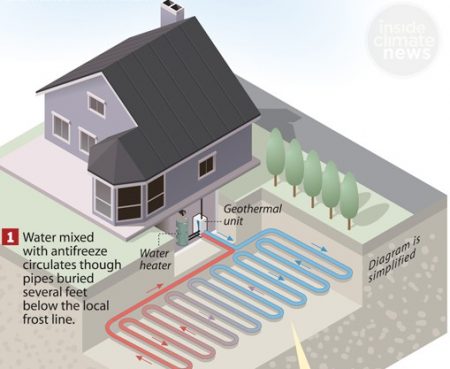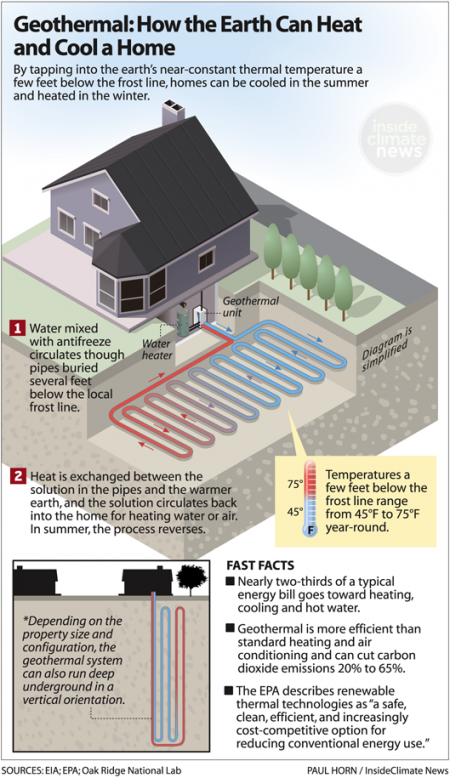February 22, 2019 – This is Emily Folk’s third contribution to 21st Century Tech Blog. Her previous two looked at how businesses will need to adapt to climate change and China’s duplicitous record of reducing carbon emissions at home while building coal-fired power plants in Developing World countries. She likes to write about sustainability and renewable energy topics. In this posting, she looks at how homeowners can implement geothermal energy systems, a near zero-emission technology. You can read more of her work at her blog site Conservation Folks.
Almost any form of renewable energy initially can be expensive to implement for the average homeowner. Families with low to moderate incomes who think of switching to renewable energy options such as geothermal find it cost prohibitive. There are, however, affordable ways to put geothermal energy to use in an average home.
As time passes renewable energy options are getting cheaper. And governments, in an effort to combat climate change are getting behind eco-friendly and sustainable energy options offering rebates, tax incentives, and other inducements. That’s why right now considering a geothermal energy option may be a good move.
What Is Geothermal Energy?
Geothermal energy comes from underground. The Earth below ground can get pretty hot. In fact at the core its temperature is equal to the surface of the Sun, just under 6,000 Celsius (10,800 Fahrenheit) degrees. That heat radiates from the core to the subsurface where by drilling down a few hundred feet you find temperatures consistently between 10 and 15 Celsius (50 to 60 Fahrenheit) degrees. Capturing the heat in the winter and the cold in the summer using this differential becomes the energy source.
Geothermal isn’t a new idea. The Greeks and Romans used the heat from pipes sunk underground to warm the water in their communal baths. But today’s geothermal systems have added heat pumps that circulate fluid through pipes that run from 10 to 300 feet below ground. So you don’t need a volcano or a subsurface thermal spring for this passive form of heating and cooling. The resource is there for the taking just a few meters below ground.
Government Incentives
As more countries focus on using greener energy, some are implementing policies that get behind renewables. Tax incentives are nothing new, but many people may not realize there are also incentives for switching to and using geothermal. In some U.S. states, commercial and residential units can qualify for a 30% tax credit applied to system and installation costs with no set cap on the purchase amount.
Canadian provinces and territories along with the federal government through its ecoENERGY Retrofit program have in the past or currently offer a vareity of tax rebates and funding programs for installation of geothermal systems.
A number of European Union countries offer similar programs.
Yet despite tax breaks and other financial incentives, only a tiny percentage of homeowners and businesses have chosen to install geothermal systems to-date. For example in the United States, according to Xiaobing Liu, a geothermal researcher at the Oak Ridge National Laboratory, around 500,000 commercial buildings out of a total of 5.6 million use the technology.
Large-Scale Installation
Installation for geothermal energy in a private home is expensive costing between $20,000 to $25,000 USD. One of the restrictrions is lot size. You need nearly twice as much land per house.That limits the market for individual home-based geothermal systems. But installing geothermal in a housing development, or in commercial buildings with good sized lot footprints is very doable. An entire neighborhood can have a geothermal system installed with heat pumps in every home. Installation on this scale brings down the cost to individual homes substantially. Over 40% of all residential geothermal heating systems in Canada have used this method for installation. This has led to thousands of geothermal system installation going into existing homes since 2007, the vast majority, almost 80%, replacing oil and electricity for heating.
More Efficiency
Upgrading to geothermal from conventional heating and cooling systems provides long-term benefits. Geothermal use is more efficient than heating and cooling by other means. It is a near-zero carbon emission technology. The energy source for the electricity to run the heat pump is your only potential emission source. Over time, geothermal will prove to be a money saver on heating and cooling costs and is rated to provide 50 to 70% better efficiency with heating and 20 to 40% with cooling than any other technologies on the market.











[…] sources to provide direct heating of buildings, greenhouses and other facilities. These include home geothermal heat pump systems that leverage heat from the ground tapped at depths as little as one metre (3.3 […]